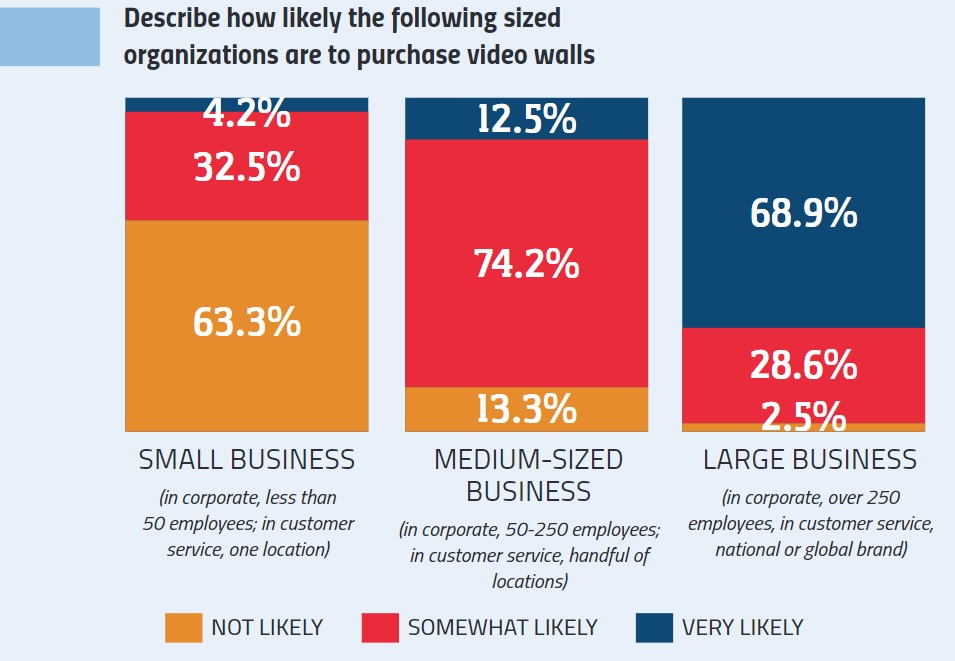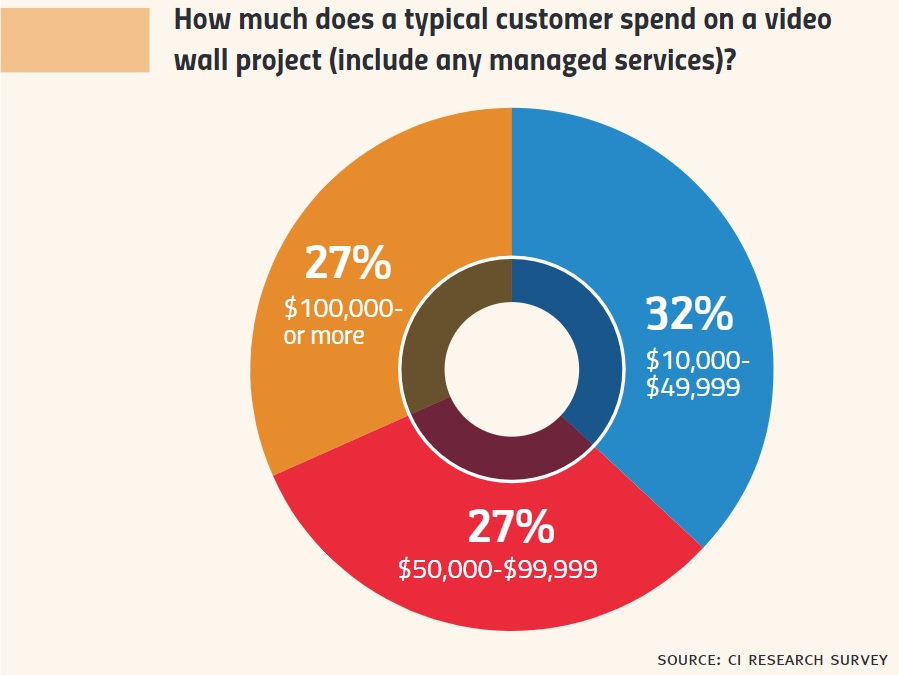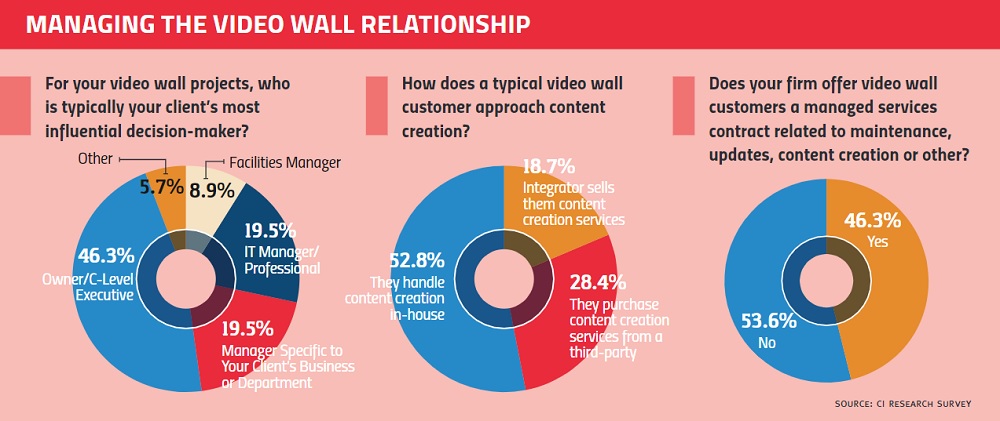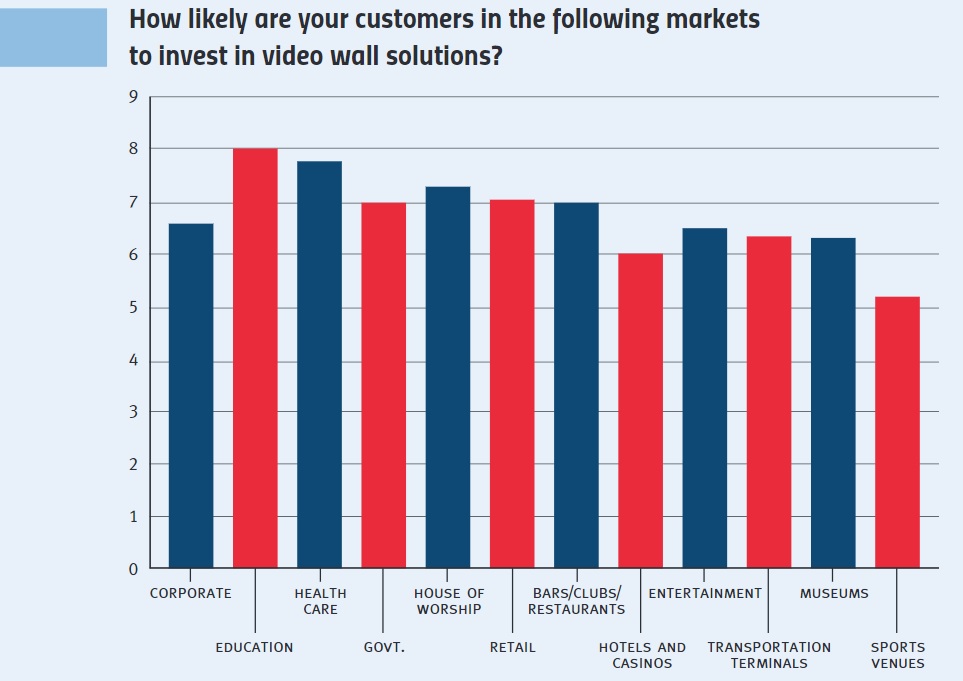If we learned one thing from our CI Research survey of integrators and AV consultants on the state of the opportunity to sell and install video walls, it’s that it’s plentiful.
Plummeting display costs and evolving technologies have expanded design possibilities and turned video walls into a viable option for customers across every commercial vertical market.
However, we also learned that there are obstacles that stand in the way of many integrators fully embracing the opportunity — some self-inflicted and some based on market conditions.
The challenge for integrators is to figure out how to take the next steps toward making the most of the video wall opportunity.
We asked several video wall professionals to pass along advice for integrators…
Jay Saret, Almo Professional A/V:
“Content, content, content. If you talk content, since most of your competitors are not likely talking content, it will strengthen your video wall business.
“It will increase the margin. It will likely provide you a recurring revenue stream, and it will strengthen the relationship you have with your customer.”
Richard Daugherty, AVI-SPL:
“Get a familiar understanding of what technologies and software options are out there.
“Having the ability to identify what solutions work best in a variety of scenarios and the exact hardware and software to deliver them is really a science and needs careful planning. DSE (Digital Signage Expo), ISE and InfoComm are great trade shows to see and hear the experts speak from experience.”
Jonathan Brawn, Brawn Consulting:
“It all comes back to seeking out the appropriate training.
“Get to the trainings that AVIXA offers, get to the trainings that you can find through Digital Signage Expo.
“[Look for] mounting certifications. Take the education because you’ve got people who are talented on your staff but they may not have enough experience in these particular areas, so take the time to sharpen that axe, get that tool ready and approach it correctly.”
Rich Ventura, NEC Display Solutions and Digital Signage Federation:
“No. 1, integrators are getting inundated by so many suppliers. We’ve seen the massive influx of Chinese LED suppliers very recently in the last few years as a really easy example. Working with established technology partners is critical …
“No. 2, don’t always look straight at the bright and shiny object. [Instead, consider] is it the right product or platform for the application itself? …
“No. 3, is really understanding and working closely with your partners, making sure your partners are adding value to what you’re doing and vice versa.”
Steve Seminario, Leyard and Planar:
“One of the most important decisions for an integrator is determining the video wall supplier with whom they choose to partner.
“In a product category with so many suppliers, rapidly changing technology, and incredibly high customer service expectations, the supplier partnership is important.
“My simple advice would be to certainly look at the product, but also look at the company, resources and people behind that product. The integrator will rely upon these factors as they support their customers over time.”
Hannah Grap, Prysm:
“It’s helping educate their customers on the real value that they can get from this type of a solution because I think a lot of customers are still going to see it as a big-ticket item that they can compromise on and maybe have a handful of smaller screens and try to deliver the same experience. It’s just not the same.
“It’s to help their customers understand that they can use it for those high-end presentations, but when it’s not in use they can use it for collaboration and ideation and having team meetings and where they can really get a lot of leverage and return on that investment.”
Stephanie Stilson, PhD, Sensory Technologies:
“Creating a more robust solution around the video wall would be helpful. You would want to nurture some kind of video content production capability, because video on a video wall is the most impactful type of content.
“You would want to secure some type of communication strategy expertise. Have someone that can talk a little bit about the broader scope of communication that the video wall will fit into. What else is happening within the organization?
“How else are they communicating? How does the video wall fit well within that scheme, or does that scheme need to be adjusted?
“Providing some kind of managed service or a cloud infrastructure that allows people to scale their use of digital messaging.”
Alison Maxson, Absen:
“Outside of finding out the right products, asking the questions, making sure it’s what their client needs — the big question that integrators need to be asking a manufacturer partner is, ‘What local support will they provide after a project is done?’
“Making sure the technology is right is one thing, but it’s also important to be there when things happen after the project and to ensure that the quality expectation by end user does not dissipate. That comes with finding a good manufacturer who has a local support with regional techs.
“If they need to fly somebody to the site for repair work, they need to be able to do that. If you’re working with somebody and all their techs and all their support is coming straight out of China you’re not going to get that level of customer service. That, to me, is the biggest differentiator.”
Kathryn Gaskell, Chief Manufacturing:
“The good news is there are a lot of options to save time and avoid frustration when creating amazing experiences for your customers. Don’t be overwhelmed with the options, reach out to your partners to solve it together. The Chief team is here to sort through the challenges you’re facing and create solutions with you.
“Integrators can stand out in 2019 by offering new, eye-catching solutions that can be customized to the space. When it comes to the installation of a video wall – make sure you understand all of the structure needs.
“Then know what hardware can help you combat any obstacles that might occur. Mounts that have flexibility in either structure or adjustments will help you save time and headache – as well as create an amazing experience for your customer.
“Content should drive the decisions – it’s what will actually end up reaching the target audience. Find the right displays and equipment to support that content.
“Make sure you are up to date on all of the options to be creative with display orientation, configurations and aesthetic finish options as well. Chief is constantly creating innovations to support new technologies and a variety of new applications. We’re here to help.”
Digital Projection Inc., Troy A. Cobb:
“Integrators looking to strengthen their video wall business in 2019 should take advantage of the weaknesses of their competitors. The most prevalent complaints we hear from end-users is that many integrators struggle to set up a video wall properly because they often lack the necessary experience and training.
“Integrators just starting in the business should look for manufacturers that offer turn-key solutions and training as well as pre-sales, installation, and post-sales support.
“Furthermore, they should look to specialize in their target market. Different applications require varying skill sets for successful installations and product/customer support.
“An integrator that attempts to be a jack of all trades is looking for trouble and will most likely fall short in offering a quality product across all product lines. However, an integrator that finds its niche is much more likely to be successful in building a stable business that offers quality products and services. In short, don’t try to be a jack of trades, you’re likely to end up a master of none.”
Nick Belcore, Peerless-AV:
“For integrators that are looking to strengthen their video wall business, it is crucial that they take some time to learn about the new products available on the market, and the best way to do this is through meetings with manufacturers.”
Derek Myers, CEO/President of Neoti:
“As the video wall market embraces new technology and the customer demands increase, Neoti recommends to build a foundation for their video wall business on these three core values. Relationship, Service and Technology.
“A video wall project, like many aspects of ProAV, is a consultative process and so without a trusted relationship with your customers and partners, your team could be left guessing what’s next or whether the video wall solution is truly what is best for the customer. In addition to a trusted relationship, service is the second value.
“While confidence can come from price or brand recognition, it’s often a false sense of security, be sure to include service in the plans.
“For example, Does the manufacturer repair only their own products on warranty or do they repair other video wall products? Last, but certainly not least, solid robust technology is the third core value.
“Proven, robust products, that provide impressive picture quality, while at the same time are easy to install, service and maintain, will impress viewers and simplify the installation while reducing the cost of ownership. “Markets” change, but values remain!”


























